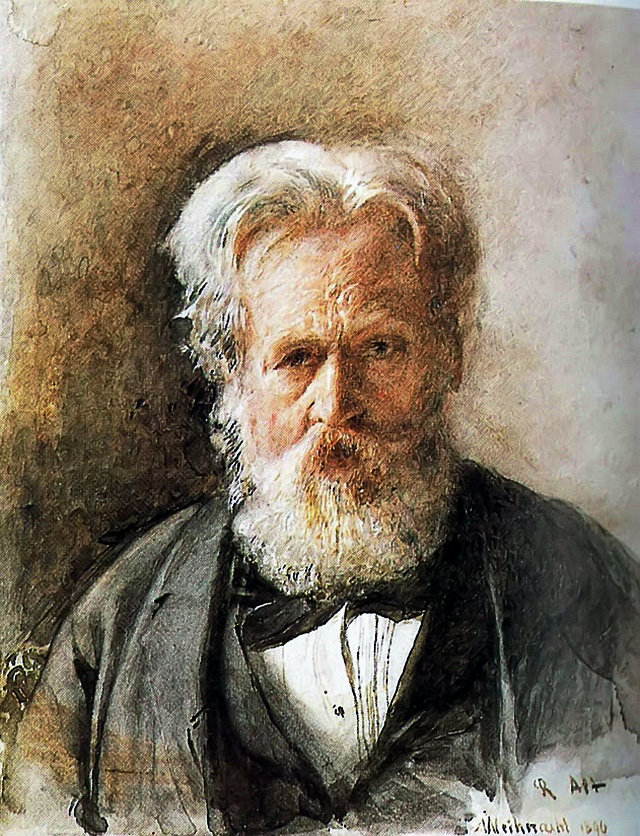Rudolf Ritter von Alt (28 August 1812 – 12 March 1905) was an Austrian landscape and architectural painter. Born as Rudolf Alt, he could call himself von Alt and bear the title of a Ritter (knight) after he gained nobility in 1889.
Biography
Rudolf von Alt was the son of the painter Jakob Alt (1789-1872) and his wife Maria Anna Schaller (1790-1872). He was born in the former Viennese suburb Alservorstadt 136 (today Alser Straße 8). His younger brother Franz Alt (1821-1914) was also a painter. He studied with his father in his workshop and colored his lithographs as a child. The father often took him along on his travels. At Christmas 1817 there was already a completely new decorated Christmas tree in the house of Alt.
1825-1832 Alt was a student of the Vienna Academy, since 1826 in the landscape class of Josef Mössmer. He soon received a 1st prize and exhibited there for the first time in 1830. Father and son made outbound trips through the countries of the monarchy and worked so closely together that it is often not possible to decide by whom a particular image was created. The highlight of their collaboration were the so-called “peep-pictures” for the later Emperor Ferdinand I.
In 1835, Alt met Moritz von Schwind and the Bavarian King Ludwig I on a study trip to Italy. 1841 until her death in 1843 he was married to Hermine Oswald from Vienna, in 1846 he married his second wife Berta Malitschek from Troppau. In the revolutionary year of 1848, Rudolf von Alt presented himself in Vienna as a civil gendarmer. As a precaution, he sent his family to the parents-in-law in Troppau. When, in the middle of October 1848, the events in the capital became too radical for the civil gendarmerie Alt, he fled Vienna with the then 16-year-old Ludwig Passini (1832-1903). In the Lower Austrian TraismauerTogether they took an emergency shelter in the Gasthof Hofkirchner (today Gasthof zum Schwan). In his memoirs he wrote, “I was National Guard in 1848, but I soon went to Traismauer, where my people lived.” On a letter envelope he recorded the situation in a quick sketch and also painted farmhouses in Traismauer in two documented works.
In 1848 he was also a member of the Academy, but this was only imperially confirmed in 1866.
Alt undertook study trips throughout Europe, in 1863 to the Crimea, in 1864 to Germany and in 1867 to Italy. In 1867 he became a member of the Berlin Academy, 1879 Professor at the Vienna Academy. Even in his later years he was interested in the latest developments in art and was therefore one of the founding members of the Vienna Secession in 1897, whose honorary president he became in the same year. Only this year he was looking at the elevation to the peerage and could from then on his behalf that by prefixing.
Rudolf von Alt liked to frequent the “Golden Lion” in the Josefstadt, where he frequented the literary figures Ludwig Anzengruber and Vincent Chiavacci.
Since 1841 he lived in Skodagasse 11, where he also died. At the house there is a plaque for him. He received a grave of honor at the Vienna Central Cemetery (group 14 A, number 52), which was designed by Josef Engelhart.
In Bad Gastein in the province of Salzburg, the Austrian painter spent the summer months of 1886-1899, completing a number of his masterful landscape paintings. Today, named after him Rudolf of Alt-Weg and the house located there with a corresponding inscription at this time.
Performance
Rudolf von Alt is one of the most popular artists of the 19th century in Vienna. His achievement lies in his mastery of the watercolor. He created more than 1000 watercolors, capturing the Austria of the time, both landscapes and above all architecture, in a topographically precise and atmospherically atmospheric way. He presented St. Stephen’s Cathedral in Vienna alone 100 times. His studio pictures by the painter Hans Makart were also well-known. In addition to his watercolors, Alt painted relatively few oil paintings. It was not until 2011 that a catalog raisonné of around 150 oil paintings was published. His patrons included the art collector Jakob Gsell.
Honors
1875 Reichel Prize of the Academy for his complete works
1877 Archduke Carl Ludwig Medal
1892 Iron Crown III. Class and Honorary Membership of the Academies of Vienna and Berlin
1894 Great golden state medal
1897 Honorary President of the Vienna Secession
1897 elevation to the peerage as “knight of alto”
1907 Designation of Rudolf-von-Alt-Platz in Vienna Landstraße
1908 honorary grave at the Vienna Central Cemetery, designed by Josef Engelhart
1912 monument at Vienna Minoritenplatz from Hans Scherpe designed
Works (excerpt)
St. Stephen’s Cathedral (Vienna, Belvedere, Inv. No. 2081), 1832, oil on canvas, 46 × 58 cm
St. Stephen’s Cathedral (Vienna Museum), 1834, oil on canvas
View of the Strada Nuova against the Giardini Publicci in Venice (Vienna, Belvedere, Inv. No. 2082), 1834, oil on canvas, 46 × 63.5 cm
Portrait of a Lady, 1838, watercolor on paper, 22 × 17 cm
View of Kremsier, (Vienna, Albertina), 1842, watercolor, 40.6 × 52 cm
The portal of the collegiate church Nonnberg (Vienna, Belvedere), 1848, oil on canvas, 36 × 27 cm
View of the kk Waffenmuseum in the Arsenal (Vienna, Museum of Military History), 1857, watercolor on cardboard
St. Mark’s Square in Venice with Austrian Military (Vienna, Museum of Military History), c. 1860, oil on paper on canvas, 35 × 44 cm
The Temple of the Vesta in Rome (Vienna, Belvedere, Inv. No. 3800), after 1867, oil on canvas, 53 × 78.5 cm
“Selbstportrait” (Vienna, private collection), 1890, watercolor on wood (fan), 30 × 40 cm
Source from Wikipedia
